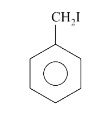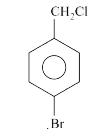Which one of the following gives white precipitate with AgNO3 ?



None of these
To determine which compound gives a white precipitate with AgNO3, we will analyze the options provided and their reactions with silver nitrate.
1. Understanding the Reaction:
Silver nitrate (AgNO3) reacts with halides to form silver halides (AgX), which can precipitate out of solution. The color of the precipitate can help identify the halide present:
- AgCl (silver chloride) is white.
- AgBr (silver bromide) is pale yellow.
- AgI (silver iodide) is yellow.
2. Analyzing Each Compound:
- Option A: 1-bromo-4-chloro-benzene:
Both halogens (Br and Cl) are directly attached to the benzene ring. Due to resonance stabilization, these halides are not easily displaced. Therefore, this compound will not react to give a precipitate with AgNO3.
- Option B: Benzyl Iodide (CH2I):
In this case, the iodine can be displaced by a nucleophile. However, the resulting precipitate would be AgI, which is yellow, not white. Hence, this option does not give a white precipitate.
- Option C: 4-bromophenylmethylchloride:
Here, the chlorine atom (Cl) is benzylic (attached to a carbon that is connected to the benzene ring), which makes it more susceptible to nucleophilic substitution. The Cl can be replaced by a nucleophile, leading to the formation of AgCl, which is a white precipitate. Thus, this compound will give a white precipitate with AgNO3.
- Option D: (not provided in the transcript, but if it were to be analyzed, we would follow the same logic as above).
3. Conclusion:
The only compound among the options that gives a white precipitate with AgNO3 is Option C: 4-bromophenylmethylchloride, which produces AgCl.
Final Answer:
C: 4-bromophenylmethylchloride gives a white precipitate with AgNO3.
---
Silver nitrate (AgNO3) reacts with halides to form silver halides (AgX), which can precipitate out of solution. The color of the precipitate can help identify the halide present:
- AgCl (silver chloride) is white.
- AgBr (silver bromide) is pale yellow.
- AgI (silver iodide) is yellow.
- Option A: 1-bromo-4-chloro-benzene:
Both halogens (Br and Cl) are directly attached to the benzene ring. Due to resonance stabilization, these halides are not easily displaced. Therefore, this compound will not react to give a precipitate with AgNO3.
In this case, the iodine can be displaced by a nucleophile. However, the resulting precipitate would be AgI, which is yellow, not white. Hence, this option does not give a white precipitate.
Here, the chlorine atom (Cl) is benzylic (attached to a carbon that is connected to the benzene ring), which makes it more susceptible to nucleophilic substitution. The Cl can be replaced by a nucleophile, leading to the formation of AgCl, which is a white precipitate. Thus, this compound will give a white precipitate with AgNO3.
The only compound among the options that gives a white precipitate with AgNO3 is Option C: 4-bromophenylmethylchloride, which produces AgCl.
C: 4-bromophenylmethylchloride gives a white precipitate with AgNO3.
Similar Questions
Knowledge Check
Which one of the following will give a white precipitate with AgNO3 in aqueous medium
A[Co(NH3)5Cl](NO2)2B[Pt(NH3)2Cl2]C[Pt(en)Cl2]D[Pt(NH3)3]Cl2Which one of the following will give a white precipitate with AgNO3 in aqueous medium
A[Co(NH3)5Cl](NO2)2B[Pt(NH3)2Cl2]C[Pt(en)Cl2]D[Pt(NH3)4]Cl2Which one of the following does not give a precipitate with AgNO3 solution ?
ACrO2−4BCl−CSCN−DClO−4
Which of the following gives white precipitate with ammoniacal AgNO3 solution?
View SolutionWhich of the following will not give a precipitate with AgNO3 ?
View SolutionWhich one of the following is likely to give a precipitate with AgNO3 solution ?
View SolutionWhich of the following does not form precipitate with AgNO3 ?
View SolutionWhich of the following does not form precipitate with AgNO3 ?
View Solution
